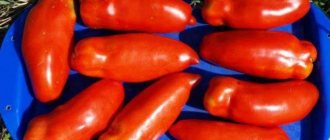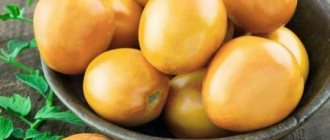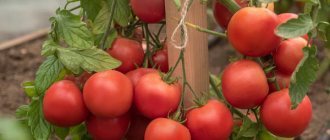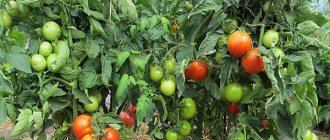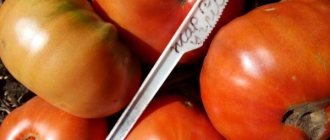What varieties are there?
Tarasenko worked as a physics teacher in the Sumy region of Ukraine, in the village of Voronezh. On his plot, he grew precisely tall indeterminate varieties - De Barao, Limon Liana, Cosmonaut Volkov, etc.
This breeder, of course, was also involved in breeding his own tomatoes. Ultimately, he obtained varieties that are still very popular among summer residents:
- Tarasenko-1, 2 and 3.
- Anniversary Tarasenko.
It is these varieties of the breeder that have earned the greatest recognition from summer residents. This specialist also developed several less popular varieties of tomatoes: Tarasenko-5 and 6, Combitomat Tarasenko, Nadezhda Tarasenko, Legend Tarasenko. These varieties, judging by the reviews of summer residents, also have good yields and are relatively unpretentious. But gardeners still grow them relatively infrequently.
Features of cultivation
Jubilee tomato Tarasenko: a spectacular representative of liana-like varieties
Tomatoes of the Jubilee Tarasenko variety can be cultivated in almost any region of Russia. But in areas with a more severe climate, where spring and even summer frosts are possible (Siberia, the Urals, the Far East), it is preferable to cultivate the crop in a greenhouse rather than in open ground.
Seeds should be planted for seedlings 60-65 days before transferring them to open ground. The specific period is selected depending on the climatic characteristics of the region:
- In the south of Russia in late February - early March.
- In the Central region, middle zone in mid-March.
- In the Urals, Siberia, and the Far East - at the end of March.
You can select the soil yourself (for example, peat, humus and turf soil in different quantities with 1 spoon of superphosphate and 300 g of wood ash) or purchase it in a store. At first, it is allowed to grow tomato seedlings in peat tablets. Plastic cups are usually chosen as containers. The instructions are simple:
- Treat the seeds and disinfect the containers in a 1-2% solution of potassium permanganate.
- Place drainage at the bottom - small stones in a layer of up to 0.5 cm.
- Then pour loose soil, add 2-3 seeds per container to a depth of 1.5-2 cm.
- Spray with water, place in a warm place (under film or glass), creating a stable temperature of 22-25 degrees.
- After the first leaf appears, plant it in different containers.
- You can feed it 2-3 times with complex mineral fertilizer.
- A week before transferring to open ground, harden at a lower temperature of 17-18 degrees.
It is advisable to provide seedlings with additional lighting - the total daylight hours should be at least 12 hours
After this (approximately at the beginning of May or at the end for the Urals and Siberia), the seedlings are transferred to open ground or a greenhouse. The landing pattern is as follows:
- The diameter and depth of the hole are approximately the same: 40-50 cm.
- The distance between them is at least 1 m.
- The distance between rows is at least 1.5 m.
Wood ash and any organic or complex mineral fertilizer are placed at the depth of the hole, which must first be mixed well with the soil and then watered abundantly. In the future, care for Yubileiny Tarasenko tomatoes is standard:
- Water regularly 3-4 times a week. The variety is drought-resistant, so it is not necessary to give water every day.
- Feed once every 2 weeks - you can add superphosphate.
- If necessary, pinching is carried out - all side shoots that form in the leaf axils are removed (2-3 times a month).
- Be sure to tie it to a trellis or other support (during the first month after transplantation).
- The soil must be mulched, which will prevent the growth of weeds and maintain a sufficient level of soil moisture. Thanks to this, you can get a particularly large harvest of tomatoes of the Yubileiny Tarasenko variety.
You can mulch the soil under tomatoes with straw or other natural materials (needles, spruce branches, sawdust)
Important! Tomato Jubilee Tarasenko can be fed with any fertilizers, except those that contain chlorine compounds.
General description of varieties
A feature of all tomatoes bred by Tarasenko is, first of all, their tallness. Their stems can reach a length of up to 2 m, and in some cases up to 3 m. Therefore, tomatoes of this variety, of course, need a garter.
The root system of tomatoes bred by this breeder can go into the ground to a depth of 1.5 m. Therefore, such tomatoes are planted in open ground using a special technology.
The yield of Tarasenko varieties reaches 10-30 kg of tomatoes per bush. Of course, not a single low-growing tomato can boast of such indicators.
Another feature of the tomatoes bred by this breeder is their long growing season. Tarasenko bred mainly early- or mid-ripening varieties. But summer residents have the opportunity to collect fruits from such tomatoes until frost.
All varieties bred by this breeder produce compact-sized fruits, ideal for canning. The yield of most varieties of this specialist is 20-25 kg per bush.
Advantages and disadvantages
The main advantages of the hybrid:
- has a sweetish taste, fleshy pulp;
- adapts well to the environment;
- fruits can hang on the branches for a long time without losing quality;
- resistance to various diseases;
- long storage of fruits after harvesting.
The only drawback is that tomatoes need to be fed and tied up.
Other Tarasenko hybrids
The series is represented by options:
- Tarasenko 6 . Medium ripe tomatoes. Fruits until early autumn. Plant up to 1.5-2 m tall. The fruits are plum-like and bright red in color. One tomato weighs up to 350 g.
- Tarasenko 7 . Tomatoes weighing from 100 to 200 g.
- Jubilee . The liana-shaped branches of the bushes reach a length of 3 m. A harvest of up to 5 kg is obtained from one bunch. One fruit weighs 200 g. The shape of the tomato is similar to a heart with an elongated top.
- Nadiya . Externally they resemble a plum, bright red in color. Fruit weight 100-120 g.
- Combitomat . Bright red tomatoes weighing up to 180 g.
- Gift to Polesie. Orange-red tomatoes weighing 100 g.
All hybrids of the Tarasenko series have similar yield indicators.
Description of tomatoes Tarasenko-1
This variety is the earliest of all, bred by a Ukrainian breeder. The fruits of Tarasenko-1 are cream-shaped and have a somewhat ribbed surface. The color of tomatoes of this variety is deep red. Their flesh is dense, juicy and quite sweet. The fruits of Tarasenko 1 can weigh from 70 to 100 g.
The peculiarity of this variety, among other things, is that it is undemanding in terms of sunlight. Moreover, it can be grown both in open ground and in greenhouses. According to summer residents, the fruits of this variety are excellent for making pickles and for fresh consumption.
The nuances of growing in open ground and in a greenhouse
Growing tomatoes in a greenhouse is slightly different from growing them in open soil. Conditions that need to be controlled when growing tomatoes in a greenhouse:
- air temperature and lighting;
- humidity, room ventilation;
- presence of carbon dioxide;
- plant water consumption standards;
- loosening, weeding, watering bushes.
At the beginning of August, flowers and ovaries, tops and side shoots are removed from the bushes. Water and feed for the last time, pick off small green fruits for rapid ripening of large-sized fruits.
In open ground, seedlings are planted in late May or early June so that the soil has already warmed up.
What is the Tarasenko-2 hybrid
The peculiarity of this variety is, among other things, that it can reach a height of 2.2 m. The characteristics of Tarasenko-2 tomatoes are simply excellent. They belong to the group of frost-resistant mid-season varieties. The fruits of this hybrid are round with a spout. Their skin and pulp are raspberry-red.
The taste of the fruits of Tarasenko 2, according to many gardeners, is simply excellent. Their flesh is very dense and sweet. It is the fruits of this variety, of all those bred by the Ukrainian breeder, that are considered most suitable for canning.
Like Tarasenko-1, this hybrid can also be grown in a greenhouse. The weight of the fruits of this variety can reach 60-100 g.
Other varieties from Tarasenko
While carrying out selection work, the amateur author cared little about his heritage. What should have been done during his lifetime should have been legitimized, but leaving a large inheritance for the vegetable growers, the author left.
During his activity, the breeder developed a sufficient number of interesting varieties, but the hybrid Tarasenko 1, such a tomato, does not exist.
The series of Tarasenko hybrids can be extended with the following varieties:
- "Anniversary Trasenko";
- Nadia (Legend);
- Combitomat;
- Gift to Polesie.
Tarasenko-3
This variety also belongs to the mid-season group. Its main advantages include abundant and long-lasting fruiting. These bushes can reach 1.8-2.2 m in height.
The fruits of hybrid tomatoes Tarasenko-3 can have either a plum-shaped or flat-round shape. Their color is bright red. Tomatoes grow quite large on this hybrid. Their weight can be 80-150 g. Tomatoes of this variety are considered suitable both for salads or fresh consumption, and for canning.
Zeblaze HYBRID 2: Characteristics
| Zeblaze HYBRID 2: | Characteristic |
| Screen: | 0.96-inch IPS screen with a resolution of 80 by 160 pixels |
| Sensors: | Heart Rate Monitor, Proximity Sensor, Accelerometer |
| IP standard: | 5ATM waterproof |
| Connection: | Bluetooth 4.0 |
| Battery: | 100 mAh |
| Waiting time: | up to 5 days |
| Size: | 44.5 x 45.5 x 15.8 mm |
| Weight: | 71 g |
| Price: | $ 46 |
Description of the variety Yubileiny Tarasenko
The Ukrainian breeder developed this tomato for his 75th birthday. Hence the name of the hybrid. The main distinguishing feature of this variety is its tallness. Jubilee Tarasenko is the most powerful variety of all bred by the breeder. The height of bushes of this variety can reach 3 m. Below the reader can see these Tarasenko tomatoes in the photo. This variety also received excellent reviews from summer residents.
A feature of Yubileiny Tarasenko is also a low degree of foliage. Bushes of this variety are well ventilated during cultivation, which minimizes the risk of developing infectious diseases.
The fruits on Jubilee Tarasenko's tomatoes grow quite large. Their weight can be 80-200 g. Tomatoes of this variety have a round or heart-shaped shape. The pulp of the Yubileiny fruits is fleshy and very tasty.
Summer residents consider uneven ripening of the fruits to be some of the disadvantages of this variety. At the end of the season, Yubileiny Tarasenko’s tomatoes often have to be picked, unfortunately, unripe. This variety is intended mainly for growing in a greenhouse. But if you wish, you can plant such tomatoes in open ground.
Varieties of the variety and their description
Feodosius Tarasenko developed his own agricultural technology for growing tomatoes, which promotes long-term fruiting and increased productivity. Varieties bred in Ukraine are taking root and delighting gardeners in Karelia, gardeners in Siberia, and farmers in the southern regions of Russia with a tomato harvest.
Hybrid Tarasenko 1
The first representative of the series, created by an amateur vegetable grower, is distinguished by its early ripening. Tomato bushes with strong roots grow up to 2 m in height. Ribbed cream has a rich classic color, one tomato weighs about 75 g, and larger specimens are also found. The variety was bred for planting in a greenhouse, where it produces high yields, but cannot withstand temperature fluctuations and is demanding on lighting.
Hybrid Tarasenko 2
Many summer residents, having planted this tomato for testing, every year buy its seeds at the kiosks for sowing, despite the fact that the bushes need to be tied up like a vine and stepsoned. One bunch of plants produces up to 4 dozen tomatoes, which is more than 2 kg. The fruits are valued:
- for excellent taste;
- delicate aroma;
- original form;
- excellent keeping quality.
Round tomatoes have smooth skin, a cute nose, and canned whole, since they weigh no more than 70 grams. After heat treatment, tomatoes do not burst and can hang on the branches for a long time without spoiling at all.
Hybrid Tarasenko 3
When properly formed, the tomato, whose height approaches one and a half meters, surprises with huge clusters with a large number of fruits weighing about 200 g, ripening in the middle period. Tomatoes have an interesting cube shape, a dense consistency, and there are no voids in the pulp. The fruits are fermented in barrels, sealed in jars, and used to make juice. Even after heat treatment they are cut into even slices. The variety is immune to fungal infections and is not affected by viruses.
See also
Description of the unique tomato variety Tsifomandra, growing seedlings and disease prevention
Read
Hybrid Tarasenko 5
In creating this mid-season tomato, Feodosius Makarovich used the Raketa variety, known at that time. On powerful bushes about 2.5 m high, tomatoes of a beautiful oblong shape are tied in clusters. The fruits, which weigh about 100 g, are harvested 108 days after planting in the ground.
Hybrid Tarasenko 6
The mid-early variety is valued for its resistance to fungal and bacterial infections and drought; in the southern regions it is grown without seedlings. Strong tomato bushes are slightly taller than a meter, but this is not an obstacle to excellent productivity. Bright red tomatoes weigh more than 300 g, have a round shape, are stored for a long time, and are not damaged during transportation.
Hybrid Tarasenko 6
A tomato of a determinate variety does not stretch upward, but grows as a bush, which still has to be tied up, since about 1 kg of fruit ripens on one bunch. Gardeners value them for their real tomato taste. The tomato does not suffer from diseases, tolerates unfavorable conditions, a large number of ovaries appear even in dry and hot weather. It is interesting that on one plant fruits ripen of approximately the same weight, about 100 g, but of different colors and shapes. Both pink and red tomatoes, elongated and round, are picked from the bush.
Tarasenko Yubileiny
Feodosius Makarovich began creating vegetable crops when he was already over 40. For his 75th birthday, the amateur developed a unique tomato, the powerful root of which grows not in depth, but in width. The weakly leafy branches of the bush stretch up to 3 meters. The main stem produces 5 racemes with a large number of flowers. Such a bunch of fruit weighs up to 5 kg. Large heart-shaped tomatoes are valued for their juicy, sweet pulp and resistance to cracking. They ripen unevenly, ripen well indoors, and are stored for a long time.
Landing Features
The technology for growing tomatoes of the Tarasenko variety is somewhat different from the methods for cultivating most other varieties of tomatoes. Summer residents usually prepare pits for these varieties in the fall. At the same time, they dig them out with dimensions of 50x50 cm and a depth of 40 cm.
The pits are placed on the site in a checkerboard pattern. The distance between them in the row is left at 1 m. The row spacing is made 1.5 m wide.
Seedlings of these tomatoes are grown in the usual way. Seeds are sown in deep boxes at the end of March. During the growing process, seedlings are watered in time and the soil under them is loosened. It is permissible not to pick Tarasenko tomatoes.
Seedlings of this variety are planted in prepared holes at an age of at least 60 days. Before planting, humus, a little wood ash and mineral fertilizers are added to the holes. Two plants are planted in each such hole. The first watering of seedlings transferred to a permanent place is carried out with warm water with potassium permanganate dissolved in it (3 g per 10 liters).
Planting dates and care features
In order for Jubilee Tarasenko to fully reveal the potential of the variety, it needs to be provided with special care.
If you don’t have the time or desire for this, you won’t be able to get 17 kg of tomatoes from a bush, although the harvest will still be very good. Seedlings are grown in the same way as other tomatoes. They are moved to a permanent place at the age of about 60 days, when the soil warms up to the following temperature:
- 15° C – to plant in the garden;
- 10° C – for greenhouses.
Landing
It is better to prepare the holes in the fall. They are dug to a depth of 40 cm, a diameter of 50 cm, and the distance between centers is maintained at 1 m.
Make a planting mixture - the top, fertile layer of soil is mixed with additives:
- humus - 2 buckets;
- ash – 3-4 cups;
- mineral complex – 50 g.
By spring, the phosphorus contained in the fertilizer will be converted into a form that can be absorbed by tomatoes and will ensure the development of a powerful root.
Plant 2 bushes per hole to grow into 2 stems. It is recommended to water each tomato with a bucket of pink potassium permanganate solution.
Formation
The stepsons are removed when they reach a length of 3-4 cm. They try not to touch the leaves - there are already few of them, but there are a lot of fruits that grow throughout the season. Only those that lie on the ground are removed. Even in those affected by pests or diseases, it is recommended to prune individual segments or parts of them.
The tops can be pinched 45 days before the expected end of the gardening season. But by this time, the main shoots in the greenhouses will reach 2.5-3 m, each will have 5-6 tassels, which will still not fully ripen. Topping is carried out after the formation of 3 clusters on each trunk.
When growing tomatoes in a heated greenhouse, more fruit clusters are left.
Garter
Tomato Tarasenko The anniversary author of the variety recommends tying it to a trellis, forming a palmette. This way the bush will be well ventilated and illuminated. A significant distance between plants will provide sufficient feeding area for a powerful root system.
You can arrange a palmette for tomatoes like this:
- Drive stakes or pipes 3 m high every 3-4 m.
- Stretch 5-7 rows of wire.
- Shoots and bunches are tied up.
Further care is the same as for other tomatoes. It includes:
- regular even watering;
- fertilizing, first with a predominance of nitrogen, then with phosphorus and potassium;
- preventative treatments;
- harvesting.
Developmental care
During the growth stage, tomatoes of this variety must be planted. Otherwise, few ovaries will form on the bushes. Most often, Tarasenko tomatoes are grown using the two-trunk method. When using this technology, you can get maximum yields from the bushes.
During development, each plant should be well ventilated and illuminated. As already mentioned, trellises are arranged in the area with these tomatoes. As tomatoes of these varieties set fruit, the lower leaves should also be removed.
Feeding and watering
Tarasenko himself recommended fertilizing these varieties three times per season. For the first time, organic matter or complex mineral compositions are applied to the plants two weeks after planting. The second time, Tarasenko varieties are usually fertilized during the period when the first fruits appear. Approximately 20 days after this, a third feeding is carried out.
Tarasenko's tomatoes are supposed to be watered once every two weeks. In arid regions, this procedure can be carried out more often. In any case, 7-10 liters of water should be poured under each plant when watering. The next day after moistening, the soil under Tarasenko tomatoes should be loosened. At the same time, weeds must also be removed from under the bushes.
How to grow tomatoes
Tarasenko-2 tomatoes have a powerful root system that grows to great depths. Therefore, when growing tomatoes, F. Tarasenko used his own methodology.
Landing
In prepared, treated and fed holes at the end of the year, plant seedlings, 2 bushes in each hole. The recess measures approximately 50x50 cm, 44 cm deep. Distance for good growth and development of tomatoes: at least 1 m between plants, 1.5 m between rows.
Care
After transplanting the plants into the soil, the following care measures are taken:
- Cover with soil and water with warm water and manganese. To prepare the solution, you need to dilute 1.5 g of manganese in 5 liters of water.
- Excess sprouts are removed from growing tomatoes (stepchildren) and tied to a support. This is done so that the bushes are ventilated and receive sunlight.
- When the first tomatoes appear, cut off or tear off the lower leaves.
- The plant needs to be watered weekly with sufficient water. Make sure the soil is loose.
- Fertilizing is done 2 weeks after transplanting into the ground. When the fruits appear, fertilize the tomatoes again, and after 3 weeks the procedure is repeated.
After planting in the ground in the first 2-3 weeks, it is recommended to loosen the soil to 10-12 cm in depth. Next, the soil is loosened by 5-8 cm so as not to damage the roots. Heavy soil is loosened deeper, to the place where the roots of the plant have not yet penetrated. Mulching improves soil temperature and moisture.
It is better to loosen the soil between the rows along with weeding and at least once every two weeks. It is better to loosen overgrown tomatoes and hill them up immediately. Hilling creates favorable conditions for warming the soil and does not allow the roots to become exposed. The first procedure is done 2-3 weeks after planting in the ground, the next - after 2 weeks. It is useful to carry out hilling together with the addition of humus.
Features of cultivation and possible difficulties
Tomatoes love fertile soil. If tomatoes grow in sandy soil, more soil moisture and the addition of humus or manure are required. Tomatoes have difficulty tolerating excess water in the ground: it interferes with air access to the roots of the plant.
It’s good if, where tomatoes grow, cucumbers, peas, carrots, cabbage, and herbs grew before. It is not recommended to plant tomatoes on the soil where potatoes grew, as they may become infected with fungi or diseases of the nightshade family. It is advisable to deeply plow the soil in the fall and fertilize it with manure at the rate of 3 kg per 1 m².
Tarasenko 2 tomatoes have the same growing difficulties as other hybrids.
The most common:
- leaf color with defects due to sudden changes in temperature after planting seedlings in the ground;
- non-infectious putrefactive lesions are caused by a lack of calcium, excess moisture, which can destroy the plant;
- sunburn;
- cracked fruits from excess water in the fruits with accelerated growth or overripeness;
- the plant does not bloom - may be caused by a sharp cold snap or lack of moisture.
Diseases and pests
Tarasenko-2 tomatoes are little susceptible to diseases. They are highly resistant to diseases such as:
- tobacco mosaic virus;
- late blight;
- altracnose;
- verticillium.
Gardeners do not even take preventive measures to combat diseases. Tarasenko himself recommended treating plants for preventive purposes on cold summer days and during long rains. It is better to treat with a 1% Bordeaux solution prepared at home (copper sulfate and slaked lime).
Common pests among tomatoes: Colorado potato beetle, mole cricket, whitefly, bugs, nematode. It is more effective to combat them with the help of fungicides.
Disease Control
In this regard, Tarasenko tomatoes usually do not cause any trouble for gardeners. Most of these varieties are highly resistant to both fungal and bacterial diseases. Summer residents who grow Tarasenko varieties usually do not carry out preventive spraying.
The breeder himself advised performing this procedure only during periods of summer cold and prolonged rains. In such weather, it is useful to treat Tarasenko tomatoes with ordinary, home-prepared Bordeaux mixture (1%).
Tomatoes Tarasenko: reviews from summer residents
Gardeners, both Ukrainian, Russian or Belarusian, have a very good opinion about these tomatoes. First of all, the owners of suburban areas praise, of course, the excellent qualities of Tarasenko’s fruits. Since their flesh is dense, they are transported absolutely without any problems.
The same applies to canning tomatoes of this variety. In jars, these tomatoes do not burst and look neat and appetizing. The taste qualities of the fruits of these varieties have earned only good reviews. The pulp of all these tomatoes, as gardeners note, is pleasant - sweet with sourness.
Summer residents also have absolutely no complaints about the yield of these varieties. According to this indicator, Tarasenko tomatoes are superior to most modern liana-like varieties. These tomatoes do not cause any particular trouble for gardeners. At the same time, summer residents have the opportunity to collect a very large number of fruits from them.

